Honor Award
Quaker Smith Point Residence
Shelburne, VT
H. Keith Wagner Partnership, Burlington, VT
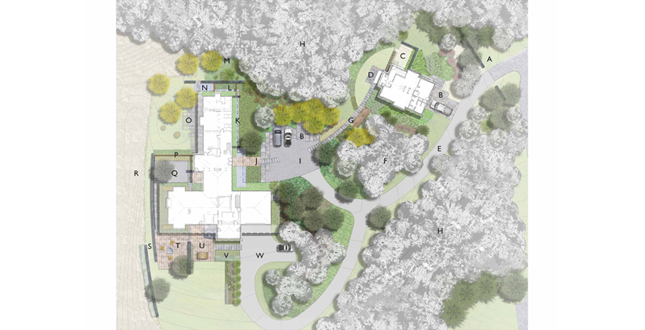
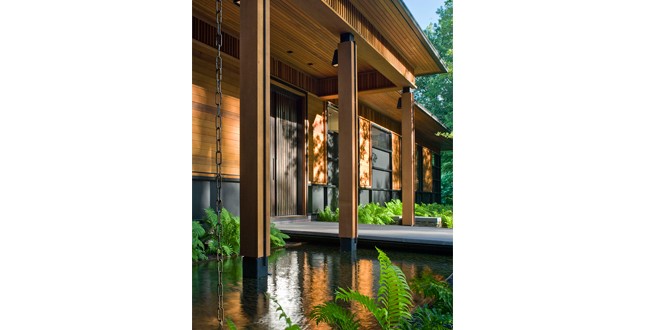 Close Me!
Close Me!A Corten steel reflecting basin forms the foreground for the house much like Lake Champlain does for the Adirondack Mountains to the west.
Download Hi-Res ImageImage: H. Keith Wagner Partnership
Image 2 of 15
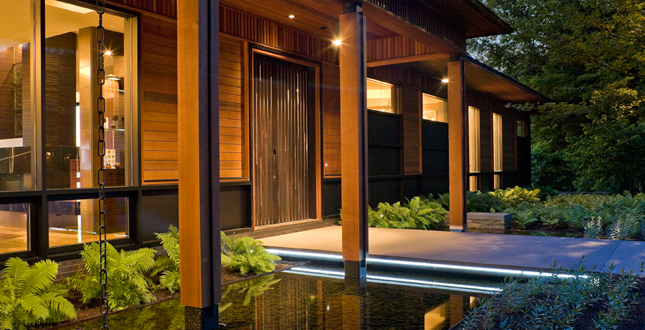 Close Me!
Close Me!At night LED lighting underneath the lilac bluestone bridge makes it appear to float lending an ethereal feel to the entrance.
Download Hi-Res ImageImage: H. Keith Wagner Partnership
Image 3 of 15
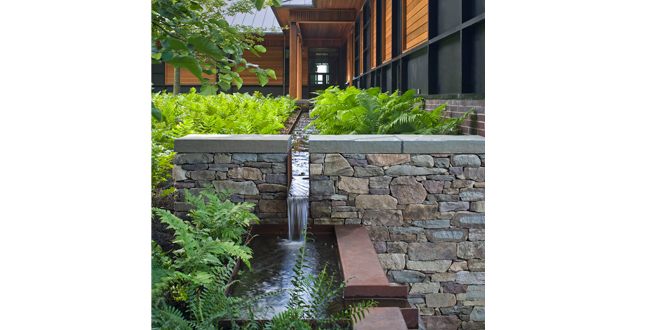 Close Me!
Close Me!The runnel, an architectural abstraction of the creeks surrounding the property, lies directly beneath the eaves of the house. As the water circulates north along the façade it bisects a stone wall and falls into a second Corten basin.
Download Hi-Res ImageImage: H. Keith Wagner Partnership
Image 4 of 15
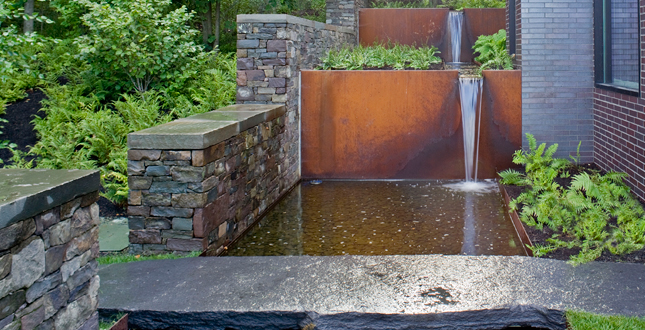 Close Me!
Close Me!From here the water cascades over two Corten walls into a final basin with a large ledge stone slab bridge. These final two falls are adjacent to the master suite and add a calming effect.
Download Hi-Res ImageImage: H. Keith Wagner Partnership
Image 5 of 15
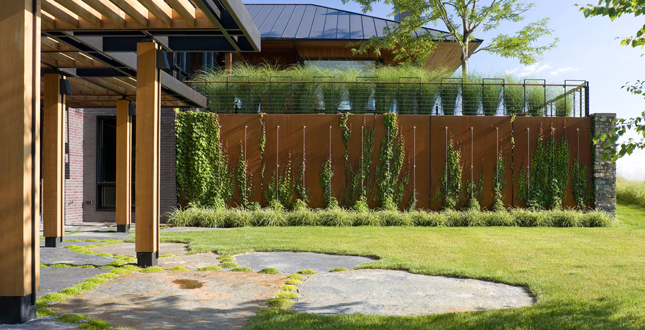 Close Me!
Close Me!A monumental Corten wall is the link between the house and the arc stone plinth wall, firmly grounding the house and transitioning between the upper and lower levels.
Download Hi-Res ImageImage: H. Keith Wagner Partnership
Image 6 of 15
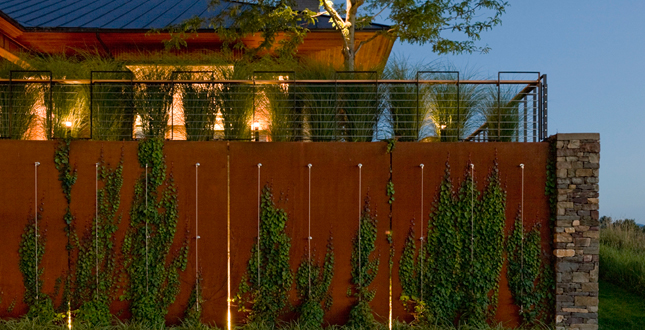 Close Me!
Close Me!Corten panels hover off of the concrete core wall adding depth at night when illuminated from within. Stainless steel cables add additional support for vines.
Download Hi-Res ImageImage: H. Keith Wagner Partnership
Image 7 of 15
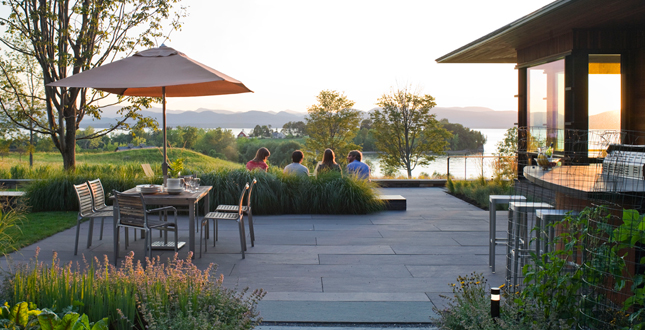 Close Me!
Close Me!The lilac bluestone dining terrace contains an outdoor kitchen clad in Corten with a cast concrete countertop, designed to withstand harsh Vermont winters.
Download Hi-Res ImageImage: H. Keith Wagner Partnership
Image 8 of 15
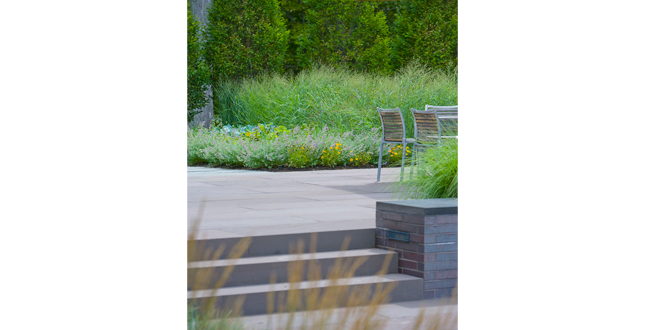 Close Me!
Close Me!The indoor steps that transition from the dining room to the sunken living room are extended outside and divide the dining terrace from the main terrace with outdoor hearth.
Download Hi-Res ImageImage: H. Keith Wagner Partnership
Image 9 of 15
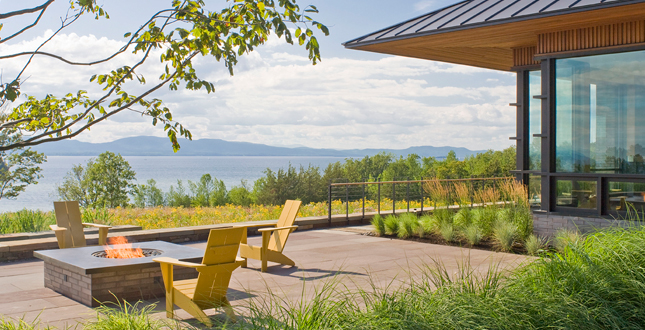 Close Me!
Close Me!Close attention was paid to setting up horizons and views from the house and terraces. The stone plinth wall allows the house and terraces float above the meadow and distant views of Lake Champlain.
Download Hi-Res ImageImage: H. Keith Wagner Partnership
Image 10 of 15
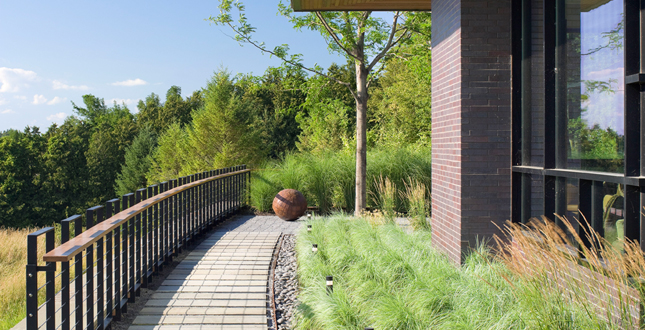 Close Me!
Close Me!A segmented bluestone walk links the main terrace with a stone dust sculpture court.
Download Hi-Res ImageImage: H. Keith Wagner Partnership
Image 11 of 15
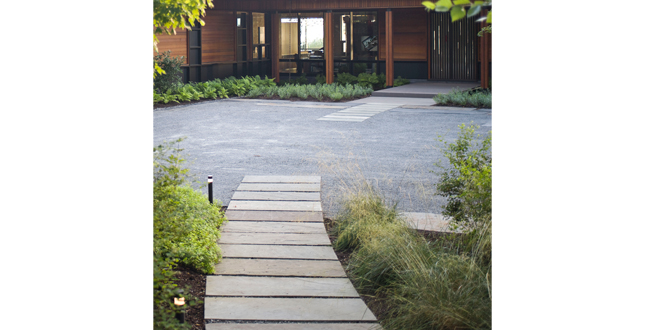 Close Me!
Close Me!The stone dust arrival court bisects the segmented bluestone walkway connecting the main house with the guest house.
Download Hi-Res ImageImage: H. Keith Wagner Partnership
Image 12 of 15
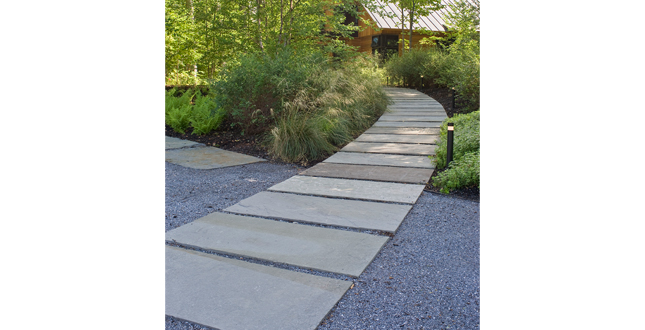 Close Me!
Close Me!The arc of the walkway and the enhanced woodland garden lends privacy to the two structures.
Download Hi-Res ImageImage: H. Keith Wagner Partnership
Image 13 of 15
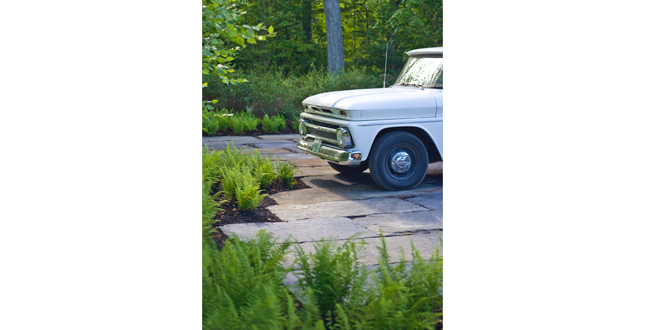 Close Me!
Close Me!Monolithic ledge stone panels set into the stone dust signify where guest are to park and begins to erode the geometry back into the woods.
Download Hi-Res ImageImage: H. Keith Wagner Partnership
Image 14 of 15
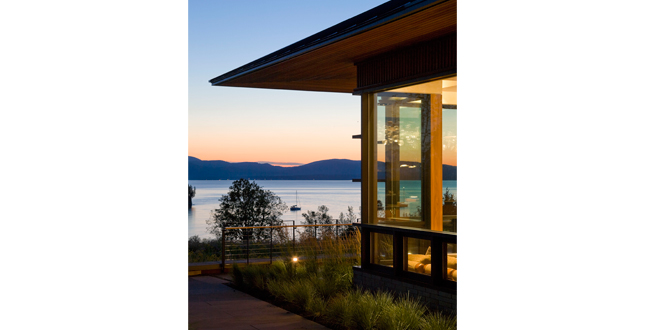 Close Me!
Close Me!The site design reinforces and forms the promontory on which the house perches.
Download Hi-Res ImageImage: H. Keith Wagner Partnership
Image 15 of 15
Project Statement
Motivated by the site’s raw beauty, a modern design aesthetic and a respect for the unique history of the site, the landscape architecture artfully integrates a new residence within the agrarian landscape. The modern built form successfully transitions into its context through thoughtful and poetic interventions - a modern re-interpretation of the 19th century agricultural estate.
Project Narrative
—2012 Professional Awards Jury
Site and Context
Shelburne Farms was originally built in 1886 by William Seward and Lila Vanderbilt Webb and was created as a model agricultural estate. With the help of architect Robert H. Robertson and landscape architect Frederick Law Olmsted, the Farm grew to a formidable 3800 acres demonstrating innovative agricultural and land use practices. In 1972, the descendants of the Webb family formed an educational non-profit for the practice of sustainable farming and forestry and, public education through sustainability and conservation programs. In order to fund the educational programs, a small number of parcels were sold within the estate as home sites. In the 1970’s a Webb family member built a home on this site.
The existing house built over 40 years ago, was not energy efficient, awkwardly sited and turned its back on the dramatic views to Lake Champlain and the Adirondack Mountains. Our clients, an art collector and an entrepreneur, were attracted to this parcel for the outstanding 10 acre house site and, the option to lease an additional 5 acres of adjacent land for their hobby, raising English Shire draft horses.
The house site included many mature shade trees and a 10’ grade change gently sloping to the lake. The clients wished to create a compound including a main house, convert an existing barn into a guest house, an arrival court, entertainment terraces, an outdoor hearth, a small vegetable garden and a water feature. In addition, the clients were interested in becoming involved with the Farm and their mission.
Design Intent
After careful site investigation, the landscape architect created a Master Plan for the compound including the adjacent parcel for a separate horse barn and pasture. Working closely with the architect, builder and client, the landscape architect sited the house to take full advantage of the views of the Lake and Mountains beyond. Orchestrating the flow of indoor rooms with the outdoor spaces and creating a marriage between the house and the grade change offered by the promontory — the distinctions between the disciplines were blurred and the new elements integrated with the site.
The outstanding views and the history of Shelburne Farms were a constant inspiration and focus for the entire design team. In order to accommodate the new house and outdoor areas, two mature sugar maples were moved during the first winter over the frozen ground and placed prominently out in the meadow, framing the views towards the lake and mountains. We worked closely with the architect to take advantage of the natural slope of the site which resulted in two distinct house levels. The upper level contains the public spaces for entertaining and the master suite, while the lower level contains guest rooms, a spa & pool. The architect and builder are a Vermont design/build company which has many in-house craftsmen that work in metal, glass & wood. This collaborative process between builder, architect, landscape architect and interior designer was critical as we worked toward achieving the design intent.
Materials & Installation
The grand 19th century structures of Shelburne Farms were built with locally available materials, slate, stone and locally harvested wood, out of necessity. We wanted to continue the tradition of using local materials while introducing Corten steel. This material eludes to the farm equipment relics that are peppered throughout the site, a homage in material to the agricultural past, present and future of the Farms.
Much attention was initially given to setting the finish floor elevation of the main house, establishing optimal solar orientation and creating a strong horizontal plinth. It was critical to get this relationship right in order to accentuate the horizontality of the view, site and architecture. The two plinth walls form an arc with a lawn ramp between them to access the lower level of the site and the meadow established as a fore ground to the lake.
The location of the existing barn foundation / guest house offered the opportunity for the arrival court to be the link between it and the main house. A stone dust auto court was created with a segmented bluestone walkway creating the link between the two structures. Local ledge stone was quarried in large slabs and used to delineate parking spaces for guests and to transition into the native landscape.
Rainwater falls off of the long horizontal roof of the house into a Corten steel basin & runnel filled with pebbles from Lake Champlain. A lilac bluestone slab forms a bridge to the front entry from the arrival court and is illuminated by linear LED lighting underneath. Native fern planting provides a field for the runnel as it flows north along the façade. A series of Corten steel & stone weirs / falls guide the water as it turns west toward the lake. The falls create a meditative calm for the adjacent master & guest suites, visible from the bathrooms. The water ends in a Corten basin with a ledge stone bridge linking the lower level terrace and a walking path to the woods. Photovoltaic panels were installed on the horse barn to significantly reduce the electricity required for the house. A pump was installed, powered by these panels to circulate the water and create a wonderful amenity of sight and sound.
At the center of the house on the west side is a stone dust sculpture court with a lone Honeylocust providing dappled shade. The sculpture court is visible upon entering the house, a foreground for the distant views. The concrete retaining wall that transitions to the lower level of the house has Corten steel panels floating off of the face. Stainless steel cable provide support for vines while at night internal lights make the steel appear to float off of the wall.
The outdoor kitchen, dining terrace & evening terrace occupies the south/west corner of the house. Internal stairs in the house that transition down into the sunken great room – extend outside as bluestone steps defining the dining terrace from the evening terrace. An outdoor kitchen counter of cast concrete sits above a Corten steel base. Cast concrete is used as a seatwall coping and surface for the outdoor hearth.
The expansive field below the house & terraces has been an experiment in meadow restoration. Our client along with Shelburne Farms & the University of Vermont Extension has established test plots to see which varieties of grasses and wildflowers are best suited to this exposed site. This project has advanced Shelburne Farm’s mission of educating the public regarding conservation and sustainable agriculture as well as upheld the long Vermont tradition of neighbor helping neighbor. Our client’s four English Shire horses regularly work on the Farms plowing fields for food production, logging and pulling sleighs and carriages for tours of the grounds.
Project Resources
Landscape Architect: H. Keith Wagner Partnership
Principal: H. Keith Wagner, FASLA; Partner: Jeffrey Hodgson, ASLA; and Project Manager: Doug Crowell, ASLA
Design & Construction Team
Arborist
Treeworks, Ltd.
Bill DeVos
Architect
Birdseye Design
Brian Mac
General Contractor
Birdseye Building Company
Jim Converse
Landscape Contractor
Colby Hill Landscape Company
Pete McGuire
Water Feature Contractor
Church Hill Landscapes
Nate Carr
Featured Products
2286P & 8301 recessed wall light
Bega Lighting
Concrete Coping on Outdoor Kitchen, Seat Wall, and Firepit
Red Concrete
Glow Star Path Light
B-K Lighting
Landscape Lighting
Epic Electric
Jim Johnson
Outdoor Hearth Gas Burner
Grand Effects
Plant Cables on Corten Steel Wall
Jakob
Stone Mason
Dave Newton Stonework
Dave Newton
Stone Mason
JKB Stone
James Bennett
Tree Mounted Down Light
Hunza Lighting
Undermounted Fiber Optic
Nexxus Lighting
Unfinished Steel Edging
Border Concepts






